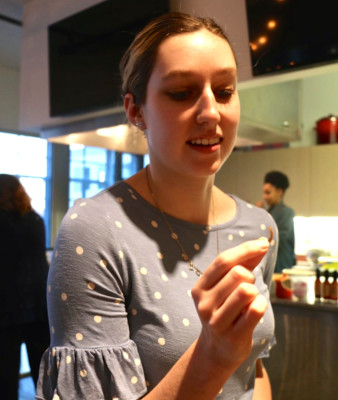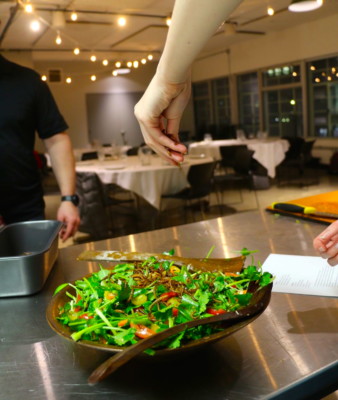Words by Andrea Beck
Photos by Arianna Gastelum
I’m not used to looking at my food and having it look back at me. Mealworms don’t have very big eyes, but somehow, seeing them sitting on top of a salad is a lot more unnerving than staring at a sliced chicken breast.
Part of it is just knowing that there are actual mealworms on this salad, replacing the usual croutons, sprinkle of nuts, or sesame sticks. If I saw a mealworm crawling on the ground outside or scurrying across a table, I would smash it, not pick it up and put it in my mouth.
Lucky for me (or not), the mealworms garnishing my helping of cilantro and tomato salad are already dead. They’ve been frozen, thawed, rinsed, and sautéed before making their way onto my plate. But somehow, that doesn’t make scooping one up with my fork and putting it into my mouth seem any less gross or unnatural.

Cooking with Creepy-Crawlies
Walking into the culinary loft at the Des Moines Social Club, you’d never guess that insects are the main protein on the menu. Each table is set up with the usual ingredients and equipment you’d expect for a cooking class: knives, cutting boards, fruits, vegetables, and herbs. The only clue walking in is the large box at the front room, near where the instructors are set up. Cardboard, with tiny ventilation holes cut in the sides: crickets.
On the menu tonight there’s a variety of creeping, crawling delicacies: Mealy Rolls (mealworm egg rolls), A-Mealy Worm Salad, Southwestern Chirpy Burgers, and Dark Chocolate Chirp Cake. From the salad to the dessert, there’s no escape from eating bugs.
Our instructors for the night, JaV’on Latimore and Cassandra Spence, start by introducing themselves, and then there’s no choice but to dive right in. Within five minutes of the start of class, I’ve already got my hand in a bowl full of mealworms, picking out skins shed by a few of the mealworms. Every now and then, the movements in the bowl make them look almost like they’re still alive.
The next hour is a blur of slicing, chopping, squeezing, and juicing. I’m working on the mealworm salad, specifically the vinaigrette, so I don’t have to worry too much about the rinsed mealworms glaring at me from the bowl. Until it’s time to sauté them, of course.
As soon as the mealworms hit the hot cast-iron skillet, they start to squirm. There were dead long before I even walked in the room, but the heat from the pan makes them expand and contract in a way that’s less than appetizing. Some of them almost look like they’re trying to crawl out of the pan. Yum.
The First Bite

Once they’re out of the pan, the mealworms are a little more brown and crispy, like any regular protein. And then they’re just sitting there. Looking at me. Waiting.
My other two group members, Dave and Kathy Hellstern, dive into the mealworms first. They’re meant for sprinkling on top of our finished salad, but they’re fresh out of the pan now, so why not get the worst part over with?
“Oh, we’re serving this to people. Somebody’s coming to our house and eating bugs before we tell them they ate bugs.” —Kathy Hellstern
Sautéed mealworms are a lot crunchier than I expected. Usually, when you imagine eating worms or crickets, you think of a disgusting burst of insect juice when you bite down on them, but the mealworms were almost too dry. I haven’t tried any insects besides mealworms and crickets, so I can’t compare their flavor to grasshoppers or beetles, but I can say they tasted a little like pine nuts.
The Benefits of Eating Insects

JaV’on Latimore, an entomologist, and Cassandra Spence, a personal chef, taught us more about edible insects than just how to sauté them. Even though Americans tend to be grossed out at the thought of chowing down on crickets for dinner, insects are pretty common in global cuisine. Countries like Thailand, Mexico, and Colombia have all been known to include insects on the dinner table, and for good reason.
“If people just replaced meat here and there, very frequently, then I think that the impact could be just as big as taking a water bottle and recycling it from one person instead of just tossing it in the trash.” —JaV’on Latimore
“When it comes to crickets and mealworms specifically, and you compare them to cows and chickens and beef and whatever there is, the protein profile is similar—in some cases for insects it can be higher depending on the type of cricket or the type of mealworm,” Latimore says. Depending on the type of insects you’re cooking, they can also be high in iron and fiber, adding more nutrients than just protein.
In addition to their nutritional benefits, eating insects can also benefit the environment. “So say someone wanted to farm their own crickets in their kitchen or in their house, or same with mealworms. They can, in such a small space, produce the same amount of protein that they can get from the store… to where they’re not going out and purchasing that meat that took an acre for one cow,” Latimore says. Not only do insects take less space to farm, but they require fewer resources, like water, too.
“If people just replaced meat here and there, very frequently, then I think that the impact could be just as big as taking a water bottle and recycling it from one person instead of just tossing it in the trash,” Latimore says.
But before you start scrounging for crickets in your backyard to save the planet, keep in mind that edible insects are farmed in a way that makes them safe to eat. Outdoor insects may have come into contact with pesticides or other chemicals that make them unsafe for consumption. You can easily find affordable insects to add to your diet though, whether you order whole mealworms and crickets online or stick to products like cricket flour and cricket protein powder.
[aesop_image img=”https://urban-plains.com/wp-content/uploads/2018/04/Edit-Use4-KP-4.jpg” panorama=”off” align=”center” lightbox=”on” captionposition=”left” revealfx=”off” overlay_revealfx=”off”]One Last Bite

When we sat down to dinner, I found that the mealworm egg rolls were my favorite, followed closely by the chocolate cricket cake. If you weren’t around to mix up the cake, or didn’t notice the mealworms peeking out of the eggrolls with each bite, you’d never know from the taste that we were eating insects. I thought there was an occasional crunch in every other bite of cake, but that might’ve just been my overactive imagination.
“Everybody has a line, and your line is always in a different spot, right? We don’t eat horses, we don’t eat dogs—we have a line,” says Kathy Hellstern, a beekeeper from Urbandale, Iowa, and one of my mealworm salad group members. “And I don’t know why our line can’t go [to] bugs, I don’t know why not. I mean, if you eat everything else, why not bugs? Just because they have legs? It seems like something you could easily add,” she says.
I asked the Hellsterns if they would ever consider adding insects to their diets on a more regular basis. “Oh, we’re serving this to people. Somebody’s coming to our house and eating bugs before we tell them they ate bugs,” Kathy says. The only thing stopping them from adding in insects more frequently is the longer prep time. “There’s something about the preparation that seems like I’m a little too lazy to go through all that work, but to me that would be the only reason it wouldn’t make itself into our normal routine,” she says.
“I love people trying things. And once you cook it yourself, what I’ve noticed is, when you’re cooking it yourself, you tend to eat it and be happy about it.” —Cassandra Spence
And even though Latimore and Spence taught the edible insects class together, Latimore was the only one who had really tried insects before creating the class. But Spence said once she got past the initial “ick” factor, she became a believer. “I thought it was going to be so much worse trying it, but when I did it I was like, ‘Ok now I can eat handfuls of these things.’ So I was just like shoveling them in my mouth. They were so good,” she says. Spence usually teaches classes on cooking ethnic cuisine, and she likes seeing her students try new things, so teaching about edible insects ended up being a good fit for her.
“I love people trying things. And once you cook it yourself, what I’ve noticed is, when you’re cooking it yourself, you tend to eat it and be happy about it. Whereas if you’re doing something new, or you’re trying something new at a restaurant, you’re kind of a little more iffy about it,” Spence says. “So cooking, and actually doing the recipes, making the recipes, cooking the bugs, prepping the bugs, really helps people kind of get over that ‘ew’ factor.”
Getting comfortable preparing and working with the insects definitely made it less intimidating for me to pop one (and then another) into my mouth. Everything we cooked ended up being much more delicious than I expected it to be, based on the name and ingredient list. So instead of asking ourselves why we should eat insects, maybe instead we should be asking “Why not?”
Recipes developed by Cassandra Spence and JaV’on Latimore

